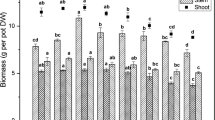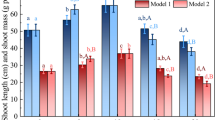Abstract
Background and Aims
Selenium (Se) is an essential micronutrient for humans and animals, but its role in plants remains unclear. Selenium enters the food chain via crops, and thus, plants constitute an essential source of Se in human nutrition. As a N2-fixing plant of high nutritive value, alfalfa (Medicago sativa L.) is an important forage legume for sustainable agriculture. This study investigated the effects of Se on carbohydrate metabolism, nodulation and growth in alfalfa. In addition, the impact of Se on fructose 1,6-bisphosphatase (F1,6-BPase), a key enzyme in carbohydrate metabolism, as well as on nitrogenase activity in N-metabolism was examined.
Methods
Alfalfa was grown either in perlite or nutrient solution at different Se (0, 1, 5, 10 and 15 μmol L−1 Na2SeO4) and N (2 and 10 mmol L−1) concentrations. Plants in perlite were inoculated with Sinorhizobium meliloti and used for studies on nodulation, growth and nitrogenase activity. Plants grown in nutrient solution were used for studies on carbohydrate metabolism.
Results
Selenium applications (5 and 15 μmol L−1) increased soluble sugars (SS) in the leaves, on average, by 44 % in both adequate-N and low-N-plants respectively. At the low-N level, Se (10 and 15 μmol L−1) increased SS in the stems and roots, on average, by 29 % and 45 % respectively. In adequate-N-plants, Se increased SS in the stems, on average, by 46 % but had no effect in the roots. Selenium (10 and 15 μmol L−1) enhanced starch accumulation in the leaves about 55 % in low-N-plants. At the adequate-N level, Se (15 μmol L−1) increased starch accumulation about 36 %. However, the starch concentrations in the roots were inconsistent. Selenium also increased F1,6-BPase activity in the upper leaflets. In addition, in low-N-plants, the low Se (1 μmol L−1 and 5 μmol L−1) applications increased nodule number (NN) about 40 % and 62 % respectively, but NN decreased with plant growth. In symbiotic plants, Se did not significantly affect nodule fresh weight (NFW), nitrogenase activity and N concentrations. Selenium also had a slightly negative effect on dry matter accumulation in shoots and roots of alfalfa.
Conclusions
The results indicate that, Se up-regulates carbohydrate metabolism via altered redox potential which may have some stimulatory effects on nodulation. These effects were, however, dependent on the Se concentration and the developmental stage of the plant. More detailed studies are needed to fully understand the role of Se in N2 fixation.



Similar content being viewed by others
References
AOAC (2002) Official Methods of Analysis of AOAC International. Volume I & II. 17th edition. AOAC International. 1st revision. Gaithersburg, MD, USA, Association of Analytical Communities
Banuelos GS, Vickerman DB, Trumble JT, Sharmon MC, Davis CD, Finley JW, Maylands HF (2002) Biotransfer possibilities of selenium from plants used in phytoremediation. Int J Phytorem 4:315–329
Broyer TC, Lee DC, Asher CJ (1966) Selenium Nutrition of Green Plants. Effect of selenite supply on growth and selenium content of alfalfa and subterranean clover. Plant Physiol 41:1425–1428
Buchanan BB, Balmer Y (2005) Redox regulation: a broadening horizon. Annu Rev Plant Biol 56:187–220
Caetano-Anolles G, Bauer WD (1988) Feedback regulation of nodule formation in alfalfa. Planta 175:546–557
Carrol BJ, Mathews A (1990) Nitrate inhibition of nodulation in legumes. In: Gresshoff PM (ed) Molecular Biology of Symbiotic Nitrogen Fixation. CRC Press Inc, pp 159–180
Cartes P, Gianfera L, Mora ML (2005) Uptake of selenium and its antioxidant activity in ryegrass when applied as selenate and selenite forms. Plant Soil 276:359–367
Chen TF, Zheng WJ, Wong YS, Yang F (2008) Selenium-induced changes in activities of antioxidant enzymes and content of photosynthetic pigments in Spirulina platensis. J Integr Plant Biol 50(1):40–48
Cooper JE (2007) Early interactions between legumes and rhizobia: disclosing complexity in a molecular dialogue. J Appl Microbiol 103:1355–1365
Cop**er RJ, Diamond AM (2001) Selenium deficiency and human disease. In Hatfield DL (ed) Selenium: its molecular biology and role in human health. Kluwer Academic Publisher, pp 219–331
de Souza MP, Pilon-Smits EAH, Lytle CM, Hwang S, Tai J, Honma TSU, Yeh L, Terry N (1998) Rate-limiting steps in selenium assimilation and volatilization by Indian mustard. Plant Physiol 117:1487–1494
de Souza MP, Chu D, Zhao M, Zayed AM, Ruzin SE, Schichnes D, Terry N (1999) Rhizosphere bacteria enhance selenium accumulation and volatilization by Indian mustard. Plant Physiol 119:565–573
Dénarié J, Debellé F, Truchet G, Promé JC (1993) Rhizobium and legume nodulation: A molecular dialogue. In: Palacios R, Mora J, Newton WE (eds) New horizons in nitrogen fixation. Kluwer, Dordrecht, pp 19–30
Djanaguiraman M, Durga Devi D, Shanker AK, Sheeba JA, Bangarusamy U (2005) Selenium—an antioxidative protectant in soybean during senescence. Plant Soil 272:77–86
Djanaguiraman M, Prasad PVV, Seppänen M (2010) Selenium protects sorghum leaves from oxidative damage under high temperature stress by enhancing antioxidant defense system. Plant Physiol Biochem 48:999–1007
Fisher RF, Long SR (1992) Rhizobium-plant signal exchange. Nature 357:655–660
Galeas ML, Zhang LH, Freeman JL, Wegner M, Pilon-Smits EAH (2007) Seasonal fluctuations of selenium and sulfur accumulation in selenium hyperaccumulators and related non-accumulators. New Phytol 173:517–525
Geiger DR, Servaites JC (1994) Diurnal regulation of photosynthetic carbon metabolism in C3 plants. Annu Rev Plant Physiol Plant Mol Biol 45:235–256
Gifford RM, Evans LT (1981) Photosynthesis, carbon partitioning, and yield. Annu Rev Plant Physiol 32:485–509
Hardy RWF, Burns RC, Holsten RD (1973) Applications of the acetylene-ethylene assay for measurements of nitrogen fixation. Soil Biol Biochem 5:47–81
Hartikainen H (2005) Biogeochemistry of selenium and its impact on food chain quality and human health. J Trace Elem Med Biol 18:309–318
Hartikainen H, Xue T (1999) The promotive effect of selenium on plant growth as trigged by ultraviolet irradiation. J Environ Qual 28:1272–1275
Hartikainen H, Ekholm P, Piironen V, Xue T, Koivu T, Yli-Halla M (1997) Quality of the ryegrass and lettuce yields as affected by selenium fertilization. Agr Food Sci Finl 6:381–387
Hartikainen H, Xue T, Piironen V (2000) Selenium as an antioxidant and prooxidant in ryegrass. Plant Soil 225:193–200
Hawker S (1985) Sucrose. In: Dey PM, Dixon RA (eds) Biochemistry of storage carbohydrates in green plants. Academic Press, London, pp 1–51
Hawrylak-Nowak B (2009) Beneficial effects of exogenous selenium in cucumber seedlings subjected to salt stress. Biol Trace Elem Res 132:259–269
Hoagland DR, Arnon DI (1950) The water culture method for growing plants without soil. California Agricultural Experiment Station Circular 347. Berkely, CA, pp 1–39
Holaday A, Martindale W, Alred R, Brooks A, Leegood R (1992) Changes in activities of enzymes of carbon metabolism in leaves during exposure of plants to low temperature. Plant Physiol 98:1105–1114
Joshi PA, Caetano-Anolles G, Graham ET, Gresslsoff PM (1993) Ultrastructure of transfer cells in spontaneous nodules of alfalfa (Medicago sativa). Protoplasma 172:64–76
Keskinen R, Turakainen M, Hartikainen H (2010) Plant availability of soil selenate additions and selenium distribution within wheat and ryegrass. Plant Soil 333:301–313
Kumpulainen J, Raittila AM, Lehto J, Koivistoinen P (1983) Electrothermal atomic absorption spectrometric determination of selenium in foods and diets. J Assoc Off Anal Chem 66:1129–1135
Lichtenthaler HK, Wellburn AR (1985) Determination of total carotenoids and chlorophylls a and b of leaf in different solvents. Biochem Soc Trans 11:591–592
Long SP, Drake BG (1992) Photosynthetic CO2 assimilation and rising atmospheric CO2 concentration. In: Baker NR, Thomas H (eds) Topics in Photosynthesis Research. Elsevier, pp 69–104
Lyons GH, Genc Y, Soole K, Stangoulis JCR, Liu F, Graham RD (2009) Selenium increases seed production in Brassica. Plant Soil 318:73–80
Malik JA, Kumar S, Thakur P, Sharma S, Kaur N, Kaur R, Pathania D, Bhandhari K, Kaushal N, Singh K, Srivastava A, Nayyar H (2010) Promotion of Growth in Mungbean (Phaseolus aureus Roxb.) by Selenium is Associated with Stimulation of Carbohydrate Metabolism. Biol Trace Elem Res 143:530–539
Marques IA, Anderson LE (1985) Changing Kinetic Properties of Fructose-1,6-bisphosphatase from Pea Chloroplasts during Photosynthetic Induction. Plant Physiol 77:807–810
Michaud R, Lehman WF, Rumbaugh MD (1988) World distribution and historical development. In Hanson AA, Barnes DK, Hill Jr. RR (eds) Alfalfa and Alfalfa Improvement. Academic Press, pp 25–91
Naisbitt T, Sprent JI (1993) The long-term effects of nitrate on the growth and nodule structure of the caesalpinioid herbaceous legume Chamaecrista fasciculata Michaux. J Exp Bot 44:829–836
Nap J-P, Bisseling T (1990) Developmental biology of a plant prokaryote symbiosis: the legume root nodule. Science 250:948–954
Padmaja K, Prasad DD, Pradad AR (1990) Selenium as a novel regulator of porphyrin biosynthesis in germinating seedlings of mung bean (Phaseolus vulgaris L.). Biochem Int 22:441–446
Paul MJ, Foyer CH (2001) Sink regulation of photosynthesis. J Exp Bot 52(360):1383–1400
Pennanen A, Xue T, Hartikainen H (2002) Protective role of selenium in plant subjected to severe UV irradiation stress. J Appl Bot 76:66–76
Pilon-Smits EAH, Le Duc DL (2009) Phytoremediation of selenium using transgenic plants. Curr Opin Biotechnol 20:207–212
Pilon-Smits EAH, de Souza MP, Lytle CM, Shang C, Lugo T, Terry N (1998) Short communications. Selenium volatilization and assimilation by hybrid poplar (Populus tremula x alba). J Exp Bot 49:1889–1892
Pilon-Smits EAH, Quinn CF, Tapken W, Malagoli M, Schiavon M (2009) Physiological functions of beneficial elements. Curr Opin Plant Biol 12:267–274
Rani N, Dhillon KS, Dhillon SK (2005) Critical levels of selenium in different crops grown in an alkaline silty loam soil treated with selenite-Se. Plant Soil 277:367–374
Sánchez FJ, Manzanares M, de Andres EF, Tenorio JL, Ayerbe L (1998) Turgor maintenance, osmotic adjustment and soluble sugar and proline accumulation in 49 pea cultivars in response to water stress. Field Crops Res 59:225–235
Sors TG, Ellis DR, Salt DE (2005) Selenium uptake, translocation, assimilation and metabolic fate in plants. Photosynth Res 86:373–389
Stinner BR, Blair JM (1990) Ecological and agronomic characteristics of innovative crop** systems. In: Edwards CA et al (eds) Sustainable agricultural systems. St. Lucie Press, Florida, pp 123–140
Terry N, Carlson C, Raab TK, Zayed AM (1992) Rates of selenium volatilization among crop species. J Environ Qual 21:341–344
Terry N, Zayed A, De Souza MP, Tarun AS (2000) Selenium in higher plants. Annu Rev Plant Physiol Plant Mol Biol 51:401–432
Turakainen M, Hartikainen H, Seppänen MM (2004) Effects of selenium treatments on potato (Solanum tuberosum L.) growth and concentrations of soluble sugars and starch. J Agr Food Chem 52:5378–5382
United States Department of Agriculture Research Service (USDA 2007) National Nutrient Database Reference Release 21, Nutrient Data Laboratory Home Page http://www.ars.usda.gov.nutrient.da
Wan HF, Mikkelsen RL, Page AL (1988) Selenium uptake by some agricultural crops from Central California soils. J Environ Qual 17(2):269–272
White PJ, Broadley MR (2009) Biofortification of crops with seven mineral elements often lacking in human diets: iron, zinc, copper, calcium, magnesium, selenium and iodine. New Phytol 182:49–84
Williams MC, Mayland HF (1992) Selenium absorption by two-grooved milkvetch and western wheatgrass from selenomethionine, selenocystine, and selenite. J Range Manage 45:374–378
Xue T, Hartikainen H, Piironen V (2001) Antioxidative and growth-promoting effect of selenium in senescing lettuce. Plant Soil 237:55–61
Yao X, Chu J, Wang G (2009) Effects of selenium on wheat seedlings under drought stress. Biol Trace Elem Res 130:283–290
Zayed AM, Lytle CM, Terry N (1998) Accumulation and volatilization of different chemical species of selenium by plants. Planta 206:284–292
Acknowledgments
The Emil Aaltonen Foundation, the August Johannes and Aino Tiura Foundation, the Maj and Tor Nessling Foundation and the Ministry of Agriculture and Forestry are gratefully acknowledged for financial support.
Author information
Authors and Affiliations
Corresponding author
Additional information
Responsible Editor: Philip John White.
Rights and permissions
About this article
Cite this article
Owusu-Sekyere, A., Kontturi, J., Hajiboland, R. et al. Influence of selenium (Se) on carbohydrate metabolism, nodulation and growth in alfalfa (Medicago sativa L.). Plant Soil 373, 541–552 (2013). https://doi.org/10.1007/s11104-013-1815-9
Received:
Accepted:
Published:
Issue Date:
DOI: https://doi.org/10.1007/s11104-013-1815-9




